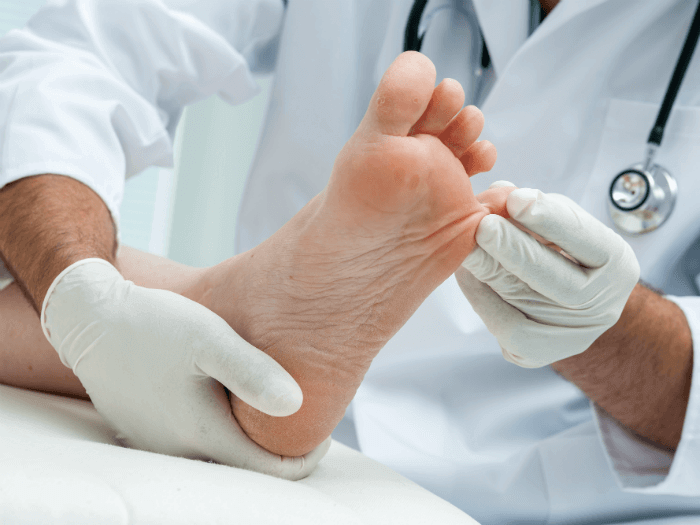If you’re not an athlete in any way, you might think it’s practically impossible for you to be affected by Athlete’s Foot—after all, it’s in the name! However, you can be afflicted with this condition regardless of your athletic demeanor, hobbies, and activities. There are many measures to prevent athlete’s foot as well.

And it’s much more common than you may think—instead of just the elite athletes in the overall population—just about anyone can be at risk for this fungal infection. All it takes is walking barefoot in moist environments that tend to be quite public, like a locker room shower at the gym or the deck of a swimming pool.
It’s so common, that podiatrists nationwide see just about three million cases of the infection annually—a lot of them being completely non-athletic.
However, despite everything we just said, it gets its name from its athletic habitual nature, since they are generally in wet shoes, wear the same sweaty or wet shoes on a daily basis for their sport and tend to shower in team locker rooms after practice—where this contagious infection can be found.
Since it’s so common, you might think that you’ll be most likely to catch it. However, there are preventable measures to prevent Athlete’s Foot.
In this article, we’re going to go through the various tips, do’s and don’ts to help you avoid not only the itching but also the burning, stinging, and infected nature.
These measures can help prevent Athlete’s Foot:
-
First and foremost, wash your feet every day!
Your mother was right in that respect—washing in between your toes and taking the time to get into the creases of your feet is very important.
Even if you weren’t particularly active that day, it’s important to take the time to wash your feet with adequate soap and water every day to help prevent Athlete’s Foot. This extra attention can scrub away any residue or possible evidence of tinea fungus.
After you’ve thoroughly washed your feet, make sure you dry them between the toes. This eliminates the moist environment where the fungus can normally breed. It’s also recommended that you use a dabbing technique when drying rather than rubbing, which can spread the infection or fungus.
-
Avoid going barefoot or with sandals—especially in public places that have water.
For example, if you’re going to be taking a quick shower in the locker room of the gym or if you’re coming out of your swimming lane and heading back to your towel, at least slip on some flip flops to avoid possible direct contact with the ground—this can help you prevent catching the fungus from the wet floor.
These areas are the perfect environment for the fungus, which likes warm, moist environments.
You also might not even think about it, but hotel rooms are also a breeding ground for this particular fungus. You could also benefit from wearing sandals or slippers when you’re walking around comfortably in your hotel room.
-
Pay attention to your socks. Whether you’re choosing a breathable material or you’re changing them out after use, your sock habits can be a great measure to prevent athlete’s foot!
Socks made out of natural fabrics or quick-dry fabrics can help you wick the moisture away from your skin and feet, which can help prevent the fungus from growing. Investing in that material can help with the prevention—especially if you’re an athlete or if you tend to wear socks and shoes every day.
Try to change out your socks every day if you can—especially if they’ve gotten wet with sweat, rain or after you’ve stepped in a puddle.
If you do play a sport and tend to use a gym bag, it also might be tempting to throw your sweaty socks in a bundle in your bag and forget about them until it’s time to do laundry. Don’t let that happen! This can create an environment where the fungus thrives and spreads, which can lead to Athlete’s Foot.
-
Your shoes also play a part.
The more breathable your shoes are, the better! If that means investing in the extra pair of shoes that can help wick away sweat and moisture, then do so! There are so many different types of running shoes that are designed with porous material and ventilation to help air out the moisture that normally builds inside.
If your shoes are made out of plastic or rubber, this can lead to sweating, which can lead to being a perfect breeding ground for fungus when wet.
You can also think about getting insoles that are water-resistant and have high-quality cushioning technology that can help keep your feet dry.
If you have the funds to buy an extra pair of shoes, you’ll want to try and alternate them, wearing one pair one day and the other the next, letting them air-dry. This can help you avoid wearing wet shoes the following day.
So, what if someone you know already has Athlete’s Foot? What do you do?
Take these precautions:
- Don’t share towels, shoes or even bed sheets or linens with that person. If at all possible, wear slippers or shoes where the infected feet have been until you can thoroughly clean out the fungus.
- Invest in antifungal powder, spray, and cream not only for the affected person but also for yourself—just in case! The powder can also help reduce foot perspiration, which can be a preventative measure you can take.
- Make sure the affected person always washes their hands after applying medication! Even by touching the affected area and going on about your day can spread the fungus—even to other parts of your body!
- Make sure that they also avoid scratching the affected skin, because this can spread it to others and other parts of their body.
We hope these preventative measures help you avoid the uncomfortable sensations of Athlete’s Foot—which is especially important if someone you work, play or live with has the infection!

